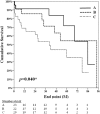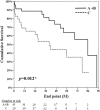Long-Term Outcomes in Coronary Artery Bypass Graft Patients Using Internal Thoracic Artery with Ipsilateral Arteriovenous Shunt for Hemodialysis
- PMID: 31371899
- PMCID: PMC6656968
- DOI: 10.6515/ACS.201907_35(4).20181208A
Long-Term Outcomes in Coronary Artery Bypass Graft Patients Using Internal Thoracic Artery with Ipsilateral Arteriovenous Shunt for Hemodialysis
Abstract
Background: The goal of this study was to evaluate the long-term results of coronary artery bypass grafting (CABG) using internal thoracic artery (ITA) grafts in hemodialysis (HD) patients with arteriovenous (AV) fistulae or AV grafts involving the ipsilateral or contralateral brachial artery or radial artery.
Methods: From March 2007 to May 2017, 76 end-stage renal disease (ESRD) patients with an upper limb AV fistula or graft for HD underwent CABG at a single center. Group A included 23 patients who underwent CABG using an ITA graft ipsilateral to the AV vascular access (AVVA); Group B included 22 patients who underwent CABG using a contralateral ITA with AVVA; and Group C included 29 patients who underwent CABG with AVVA without the use of an ITA graft. The primary end-point was death from any cause.
Results: The average follow-up period was 34.4 ± 26.9 months. Death from any cause occurred in 6 (26.09%) patients in Group A, 8 (36.36%) patients in Group B, and 17 (58.62%) patients in Group C (log-rank p = 0.04). There was no significant difference in death rate between Groups A and B. The risk of death was lower in the patients with CABG using an ITA graft (ITA CABG) compared to the patients without ITA CABG [HR 0.41 (95% CI, 0.20-0.84), p = 0.015].
Conclusions: The HD patients who underwent CABG with an ipsilateral location of the ITA and AVVA did not have an increased risk of death compared to the patients who underwent CABG with a contralateral location of the ITA and AVVA. In addition, the use of ITA in CABG resulted in better outcomes in the HD patients.
Keywords: Chronic renal failure; Coronary artery bypass graft; Steal phenomenon; Uremia.
Figures




Similar articles
-
Effect of arteriovenous hemodialysis shunt location on cardiac events in patients having coronary artery bypass graft using an internal thoracic artery.Ther Apher Dial. 2014 Oct;18(5):450-4. doi: 10.1111/1744-9987.12158. Epub 2014 Jan 14. Ther Apher Dial. 2014. PMID: 24417873
-
Effects of the side of arteriovenous fistula on outcomes after coronary artery bypass surgery in hemodialysis-dependent patients.J Thorac Cardiovasc Surg. 2014 Feb;147(2):619-24. doi: 10.1016/j.jtcvs.2013.01.031. Epub 2013 Feb 10. J Thorac Cardiovasc Surg. 2014. PMID: 23402689
-
Effect of hemodialysis access blood flow on cardiac events after coronary artery bypass grafting using an internal thoracic artery.J Vasc Access. 2017 Jul 14;18(4):301-306. doi: 10.5301/jva.5000693. Epub 2017 Apr 14. J Vasc Access. 2017. PMID: 28430311
-
Reusing the patent internal mammary artery as a conduit in redo coronary artery bypass surgery.Interact Cardiovasc Thorac Surg. 2016 Mar;22(3):346-50. doi: 10.1093/icvts/ivv338. Epub 2015 Dec 15. Interact Cardiovasc Thorac Surg. 2016. PMID: 26669852 Free PMC article. Review.
-
High-Output Cardiac Failure and Coronary Steal With an Arteriovenous Fistula.Am J Kidney Dis. 2018 Jun;71(6):896-903. doi: 10.1053/j.ajkd.2017.10.012. Epub 2017 Dec 23. Am J Kidney Dis. 2018. PMID: 29277506 Review.
References
-
- Wen CP, Cheng TYD, Tsai MK, et al. All-cause mortality attributable to chronic kidney disease: a prospective cohort study based on 462 293 adults in Taiwan. Lancet. 2008;28;371:2173–2182. - PubMed
-
- Masakane I, Nakai S, Ogata S, et al. An overview of regular dialysis treatment in Japan (As of 31 December 2013). Ther Apher Dial. 2015;19:540–574. - PubMed
-
- Wu PC, Wu V. Chronic kidney disease in Taiwan’s aging population. Acta Nephrol. 2014;28:20–21.
-
- Sunagawa G, Komiya T, Tamura N, et al. Coronary artery bypass surgery is superior to percutaneous coronary intervention with drug-eluting stents for patients with chronic renal failure on hemodialysis. Ann Thorac Surg. 2010;89:1896–1900; discussion 1900. - PubMed
LinkOut - more resources
Full Text Sources
